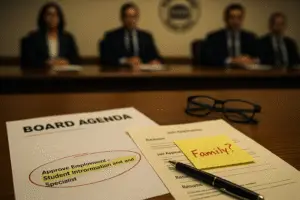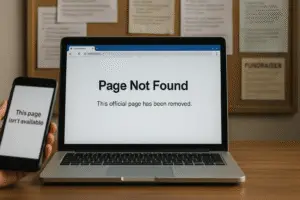EL CAJON, CA— Public education was once considered the great equalizer. The promise was simple: no matter your ZIP code, background, or bank account, your child had the right to a fair shot—a seat in a classroom governed by shared standards, staffed by credentialed professionals, and accountable to the public.
But somewhere along the way, that promise broke—and many families, desperate for better options, turned to charter schools instead.
Charter schools—originally designed as laboratories of innovation within the public system—have morphed into a patchwork of private nonprofits, enrichment vendors, and independent study programs. Instead of expanding opportunity, they often entrench inequality—offering boutique experiences to families who can navigate the maze, while everyone else gets what’s left.
Make no mistake: enrichment is important. Every child deserves access to art, music, movement, and hands-on learning. But access should not depend on whether a parent is home during the day, speaks fluent English, or knows how to submit receipts for private jiu jitsu classes labeled as “P.E.” Students in these programs aren’t just learning differently—they’re being offered more, under the banner of equity, while students in traditional public schools are being asked to make do with less.
What began as a push for flexibility has become a publicly funded free-for-all. Tax dollars now pay for pottery lessons, private music instructors, surfing classes, and other “curriculum” that resembles summer camp more than school. These aren’t fringe examples—they’re increasingly common in independent study charters, where the line between educational innovation and taxpayer exploitation has all but disappeared.
Meanwhile, many of these charters operate with hardly any public oversight. In most cases, their boards aren’t elected. Their leadership isn’t accountable to local communities. They aren’t bound by the same rules as school districts—and they know it. When fraud is exposed—like in the A3 charter scandal that siphoned over $80 million in public funds—we’re told it’s an anomaly. But it’s not. It’s the logical outcome of a system that hands out public money with private rules.
Let’s be honest: this isn’t about learning. It’s about access. If your family has the time, the resources, and the savvy to leverage these programs, your child may thrive. But if you don’t? You’re left behind. That’s not “choice.” That’s a two-tiered public education system pretending to be equitable.
And here’s the worst part: we all pay for it. Taxpayers are footing the bill for custom-built education plans that serve the savvy. The public funds it, but the public has no seat at the table. This isn’t reform—it’s privatization in disguise.
I’m not against charter schools. I’m against what many of them have become.
If we truly believe in public education, then every publicly funded school—charter or not—must be:
- Publicly governed
- Publicly accountable
- Equitably accessible
This doesn’t mean eliminating flexibility. It means requiring that flexibility operate within shared public standards. It means recognizing that when the system rewards those with the most time and resources, it ceases to be a system of equal opportunity.
So no, I’m not here to dismantle choice. I’m here to defend public responsibility.
Let’s stop calling privilege “choice” and start calling it what it is: a quiet dismantling of the public good, one tax-funded perk at a time.
And let’s build a new standard—one where every student, regardless of circumstance, gets the education they deserve. No loopholes. No handouts. No boutique benefits for the few. A system, governed by one principle:
Public funds demand public standards.
The Good, The Bad, and The Lessons
Charter schools often bring something back into education that’s been stripped away from many public classrooms: joy. Creativity. Flexibility. A sense of possibility. I’ve seen firsthand the rigid boundaries around traditional schools—the allergy to risk, the fear of litigation, the policies that slowly push out the very humanity of childhood. Homemade cookies are banned. Class parties are gone. Field trips trimmed. Fun heavily filtered. And while safety is paramount, the unintended consequence has been a slow erosion of what makes school feel alive.
We’ve legislated out the magic that made school fun.
Charters, at their best, reintroduce that spark. And that’s exactly why we shouldn’t let them become luxury goods for the few. If there are things they’re doing well—project-based learning, mentorship, whole-child education—then we should scale those practices across the entire system, not silo them inside boutique nonprofits.
And likewise, charters have something to learn too: structure matters. Oversight matters. Equity matters. Because the minute flexibility becomes a loophole, or personalization becomes privatization, we’ve lost sight of what matters—every child we have an obligation to serve, and the public that has entrusted our institutions to do so with their tax dollars.
So no, I’m not calling to end charters. I’m calling for a better, braver public school system—one that doesn’t just regulate to avoid liability, but invests to create opportunity. One that doesn’t strip away joy in the name of order, but builds structure around humanity. One where every child, in every ZIP code, feels seen and served—not just academically, but as a whole person.
But maybe the real question isn’t why parents choose charters. Maybe it’s why so many found it easier to walk away from public schools in the first place.
Public education, for all its structure and standards, has too often become a place of rigidity, red tape, and burnout—where joy is legislated out, and the spark of learning dims under pressure. Parents don’t flee because they’re chasing perfection. They leave because they’re tired of fighting a system that feels broken. Because in some charter models, they find something public schools forgot how to offer: joy. Flexibility. A sense of possibility, and happy, confident children.
The goal isn’t to eliminate alternatives.
The goal is to build a system so responsive, so humane, so alive—that families stay because they want to, not because they ran out of patience.
And here’s some food for thought: how many of the people leading our government, shaping public policy, or sitting in positions of power enroll their own children enrolled in public schools? Many of our own lawmakers and governmental figures have their own children in private schools, flex-based learning models, charters, and homeschooling.
That alone should tell you something. When the very people tasked with stewarding public education choose not to entrust their own children to it—despite having every means to choose otherwise—we should be asking hard questions. What do they know that we don’t? Or more importantly, what do they accept as “good enough” for the rest of us that they wouldn’t dare accept for their own?
Charter schools have valuable contributions to make. But they must come with greater accountability and oversight. Public schools, too, have things to learn from what charters do well. There are strengths and shortcomings in both systems—and real reform starts with acknowledging that each has something to teach the other.
Representation Without Voice
There’s another quiet instability baked into the charter system—one most families don’t even realize until it’s too late. The fate of a charter school often lies not with the families it serves, but with the elected board of the district that authorizes it. And that board? It answers only to the voters who live within its boundaries—not to the thousands of charter families who may live elsewhere, pay taxes elsewhere, and hold no voting power in that district at all.
That means a single small-town school board—elected by perhaps fewer than 2,000 residents—can control the future of a charter that serves 13,000 students throughout multiple counties and an entire southern portion of the state. If that board flips in a local election, the charter can lose its authorization entirely. The families who relied on it have no vote, no voice, and no recourse. The rules may shift. The renewal may be denied. And the students—many of whom enrolled for stability or to escape dysfunction—are left scrambling.
It’s a system where representation is lopsided, yet the consequences are profound. Charter families fund the system through taxes like everyone else, but they don’t get a seat at the table where decisions are made. It’s a form of governance that resembles taxation without representation—not by intention, but by design.
And in that design, there’s a deeper tension: how can we justify a system where continuity of education for thousands depends on the political whims of a voting bloc that may never set foot on the campus?
Conflict of Interest: When Pepsi Regulates Coke
Charter schools were created to offer alternative pathways within public education. But in small, rural districts where enrollment is low and budgets are thin, the charters have become the cash cow—and the districts, desperate for funding, have taken on the role of eager host rather than neutral overseer. It’s a clear conflict of interest. And it’s not about charters being treated unfairly. It’s about them being favored at the expense of the very students districts are elected to serve.
Let’s call it what it is: Pepsi is regulating Coke—and rooting for it to succeed over their own brand. Because every charter they approve brings in 1–3% in oversight fees. And unlike their own campuses, they don’t have to educate those students, no educating, just the money. Just cash the checks.
So when district leaders spend their time courting new charters, chasing oversight dollars, and building administrative infrastructure around remote programs—that attention is being pulled directly away from their own classrooms. The students sitting in those seats, in those towns, in those schools, are no longer the priority. They’re the forgotten ones.
You see it in the data:
– Reading scores plummet
– Math proficiency drops
– Programs and electives disappear
– Staff morale tanks
Meanwhile, the charter pipeline keeps expanding—
And district leaders keep cashing in.
This isn’t just misaligned priorities. It’s a structural failure of governance. The same body entrusted with educating the children in their own community is incentivized to prioritize students they’ll never meet, in cities they’ll never visit, through programs they don’t manage—just to stay financially afloat.
When oversight becomes a revenue stream, education becomes a side hustle.
Ghost Campuses and Distant Districts
A growing number of California’s small school districts have quietly taken on the role of charter authorizers for schools located far outside their own boundaries. These schools—many of them virtual, independent study, or hybrid models—may serve thousands of students across a portion of the state, yet they remain legally tethered to a tiny rural district that may have fewer than 100 students of its own.
The incentive is clear: the district receives substantial income without the burden of educating the students themselves. It’s a low-effort revenue stream for cash-strapped districts. But the cost is often borne by the children in the district’s own backyard.
With administrative focus diverted to charter contract oversight, compliance, renewals, and performance metrics for students they will never meet, the quality of local education can quietly erode. Public school students may find themselves in under-resourced classrooms, while their district is busy managing legal and financial obligations for schools that operate entirely outside of their communities.
While the practice is legal under California’s current charter framework, critics say it undermines democratic representation, financial transparency, and the core principle of local control. Charter schools—originally intended to foster innovation within the public system—have become commodities traded between districts, where approval is sometimes less about pedagogy and more about revenue.
The consequences aren’t theoretical. They’ve already begun playing out across the state.
It’s time we stopped pitting public and charter against each other, and started asking the real question:
What would it take to build a school system where joy, equity, and excellence live together—and no child has to win the lottery to access it? That’s the system I believe in.
That’s the system worth fighting for.
As the charter landscape continues to expand, it’s clear the current authorizing structure wasn’t designed for this scale—or this kind of power imbalance. How can California preserve the innovation of charter schools without sacrificing the integrity of public governance or the students left behind?




